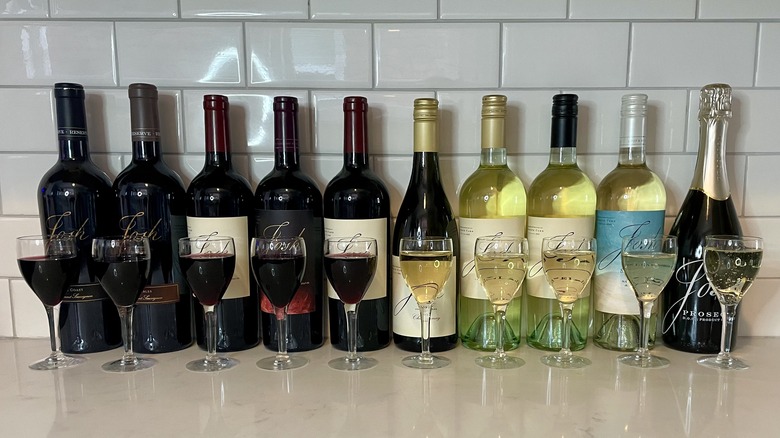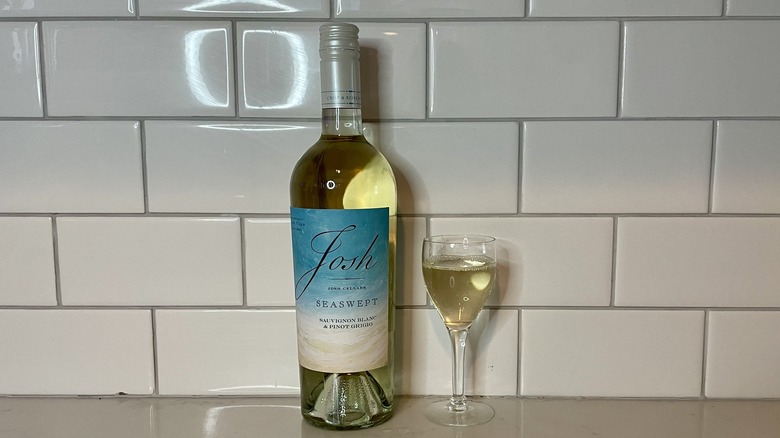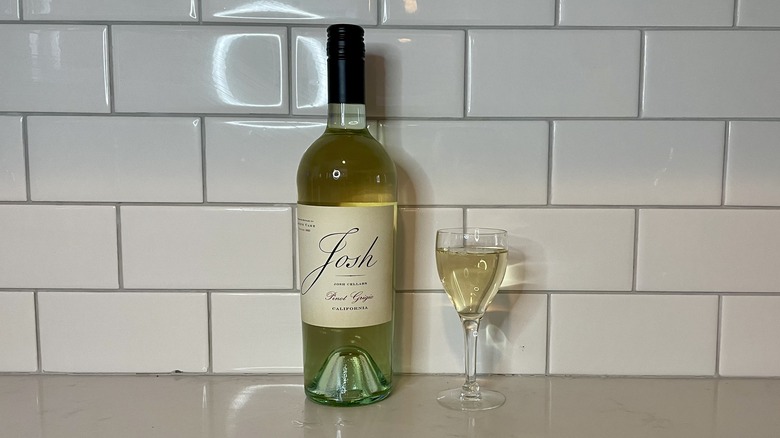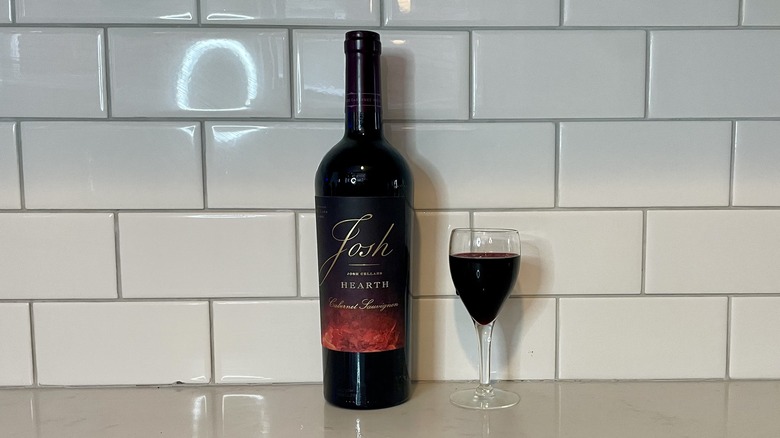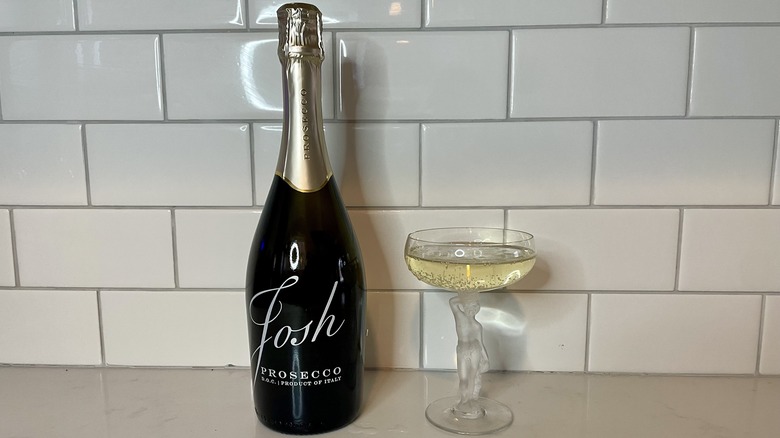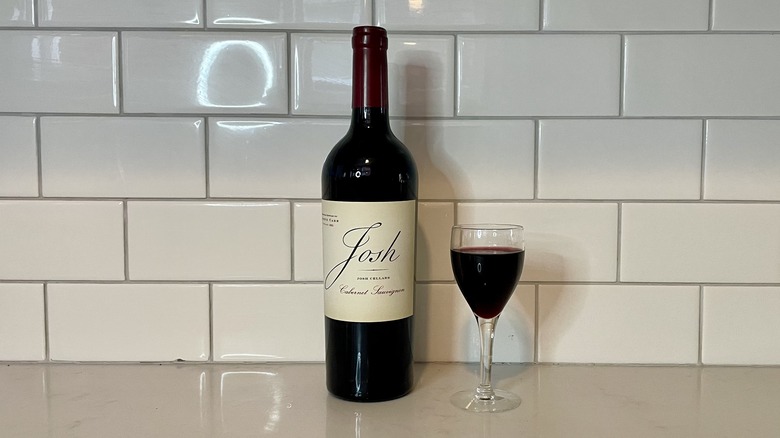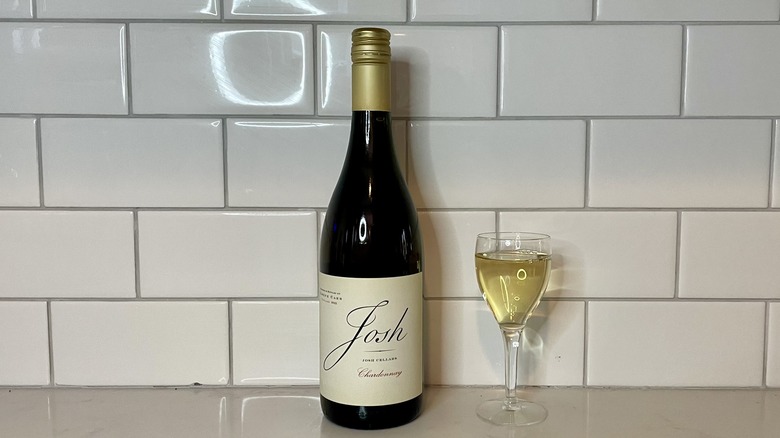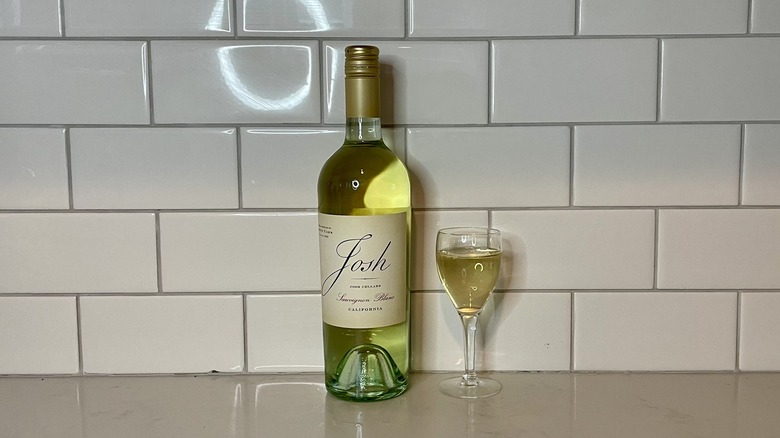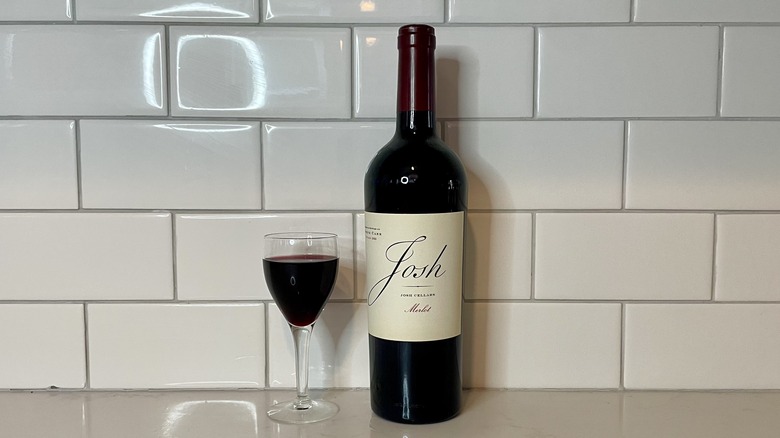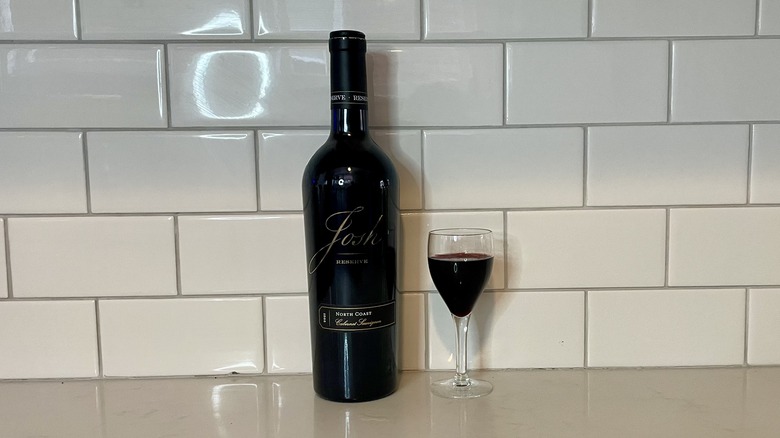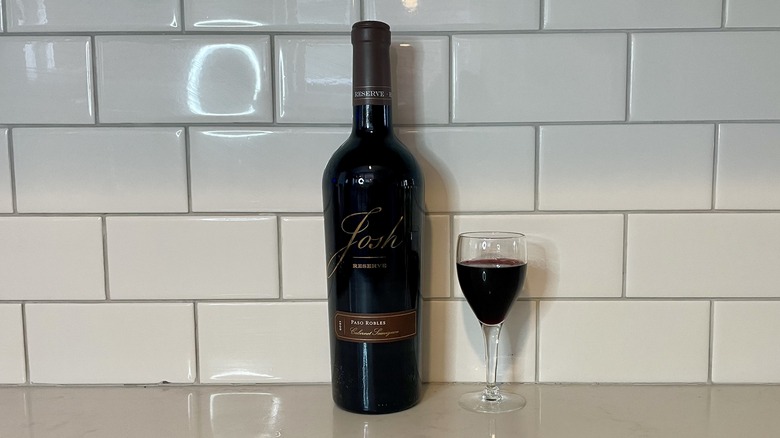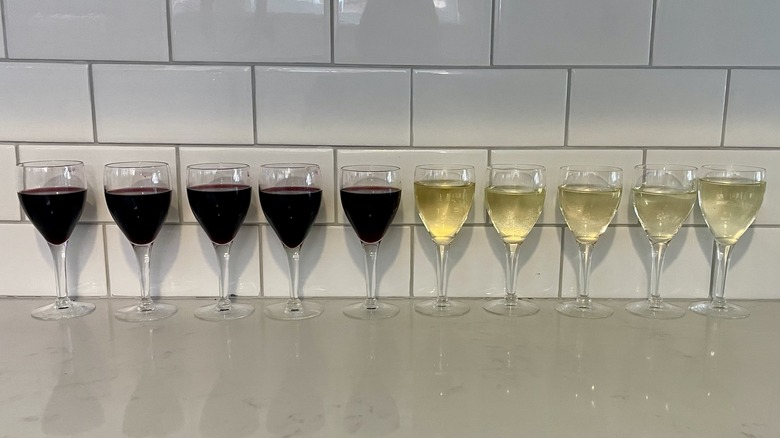Josh Cellars Wine, Ranked Worst To Best
While Josh Cellars was founded in 2007 by wine enthusiast Joseph Carr, the story of Josh Cellars actually goes back a little further. In 2004, Joseph Carr Wines started as a premium brand making European-inspired wines in Napa. While these wines are undoubtedly delicious, they came with a high price tag.
Carr founded Josh Cellars to bring a line of budget-friendly wines to a larger audience. The wine is named for Carr's father, a lumberjack. The name pays homage to Carr's family while also providing smart, simple branding. The branding strategy worked, and Josh Cellars has been memed a number of times and even made an appearance on an SNL sketch. While these memes do poke fun at the brand, they also drive home the appeal of the wine as a mid-range, approachable table wine with a memorable moniker.
Josh Cellars started with one type of wine but has since expanded to a number of varieties and styles. The company provided us with a selection of its wine so we could give it an honest review. We tried 10 wines and compared them to each other. We also judged each wine based on how faithfully it represents its grape varietal.
10. Seaswept 2023
Seaswept is a blend of sauvignon blanc and pinot grigio, both of which appear on this list independently. This wine has a markedly different label than most of the others, a label that is reminiscent of a seascape. This is noticeably more playful than Josh's typical label design — playful is an excellent way to describe this wine.
Seaswept has light notes of peach and citrus fruit. But ultimately, there is just not much more going on here; it is not a terribly complex wine. That said, it was not intended to be. In our discussion with a Josh Cellars representative, they described it as a wine you might appreciate while sipping it by the pool. This wine is clearly meant to be fun and refreshing on a hot day. While this may be true, that does not make it a great everyday wine. The limited range makes it ideal for only certain times of the year when the weather is appropriate. Additionally, it doesn't add much when paired with a meal — the company does not recommend pairing it with food. Because of such factors, it dips below the rest of the wines on this list.
9. Pinot Grigio 2022
This pinot grigio hits most of the expected tasting notes for the style, with definite hints of melon. This wine is bright and crisp, but it is also overpoweringly acidic. This is a common problem, as pinot grigio is known as one of the more acidic wines. Notes of citrus are typical, along with some of the tang you expect with that. Since this is a California pinot grigio, though, we hoped for a less sour flavor; higher acidity is more common in Italian-grown grapes. Each sip of this pinot introduced acid right at the back of the mouth.
If all you are after is a dry white wine, then this is a decent option. However, it didn't have us heading to the store to buy more. That said, it does offer a fuller mouthfeel than some other pinot grigios, which means it transitions better into colder weather. While Seaswept must be drunk in warmer weather, this wine can be consumed in cooler times as well. Though it's not our favorite, the pinot's versatility does make it better than Seaswept.
8. Hearth Cabernet Sauvignon 2021
Josh Cellars started with cabernet sauvignon, but not this particular cabernet sauvignon. This is one of its newer additions. Speaking with the representative, our suspicions that Hearth was a counterpart to Seaswept were confirmed. We see why. Where Seaswept is light and bright, this wine is deep and smokey. If you are looking for a wine to try in the dead of winter, this is the one. Sadly, that may be the only time it will be particularly enjoyable.
Cabernets are typically deep and bold with notes of blackberry. Hearth has that, but it also tastes like a smoldering fire. It is sweet and smokey, like a toasted marshmallow with heavy notes of vanilla. Whiile the other cabernets are subtler, Hearth is in your face with flavor, which is not a phrase typically ascribed to cabernet sauvignon.
Hearth is meant to be enjoyed while cozied up by the fire on a winter day. At 14.5% alcohol, this cabernet is higher in alcohol than Josh Cellars' other cabernets, which helps the drink feel even warmer. The strong smokey notes mean the drinker will either love it or hate it. This divisive flavor profile prevents it from ranking higher.
7. Prosecco
As of this article, this is the only Josh Cellars wine not produced in the United States. Instead, this Prosecco is made in Italy. Much like true Champagne only comes from a particular region in France, Prosecco can only be called Prosecco if it's produced in the Veneto in Italy. Unlike most of the other wines on this list, the name represents the area of origin, not the kind of grape used. This wine is made with glera grapes.
The bubbles are big and plentiful, larger than some other sparkling wines. The flavor is bright and offers natural notes of orange, pears, and a finish of honey.
This is a perfectly fine Prosecco. There is nothing glaringly bad about it. However, for a semi-dry Prosecco, we did find it a smidge sweet. This Prosecco would be a great base for a Prosecco cocktail, but at the price point, it should be good for sipping and not just for mixing. Josh is still in the early phase of its endeavors to branch out beyond California, so maybe future vintages will allow the company to hammer out the details of this wine.
6. Cabernet Sauvignon 2021
This is the original Josh Cellars wine, and its success and popularity allowed the company to branch out to other types of wine. Although it may not rank the highest, this bottle remains a solid choice.
This cabernet sauvignon features the fruity notes this grape is known for. Notes of blackberry and cherry are mixed with warm spices and oak. This wine is warm and comforting without going overboard.
The reason this particular wine does not rank higher on this list is simply because there are better and more interesting caberrnets from Josh Cellars. This would be a great wine to serve as a day-to-day wine with dinner. It is also a best seller for the company.
However, there is nothing particularly special or innovative about it other than it being the line's first wine. While it is a perfectly good wine and we are sure it will always hold a special place in the company's heart, it is worth looking beyond this cabernet to some of the company's other choices.
5. Chardonnay 2022
We have the founder's late wife to thank for the creation of this wine. As mentioned, when Josh Cellars first started, the only wine it offered was a cabernet sauvignon. However, as the company representative told us, Joseph Carr's wife, Deirdre, was a chardonnay fan and wanted a wine she would enjoy. Carr made this wine for her, and we are so glad he did.
It is easy to find chardonnay that tastes like an oak tree. Instead, in this bottle, Josh Cellars lets the grapes shine through while using oak to heighten the senses. The immediate aroma of this chardonnay is rich and buttery. There are also sweet notes of caramel. The flavors are bright, with notes of guava and vanilla. There are also lightly spiced notes that add to the overall taste. This chardonnay is a dry wine, but with hints of caramel and butter, it almost feels sweeter than it really is. This would be a good chardonnay to give someone who is on the fence about the grape. The delicate approach to the flavors makes it easy to enjoy and boosts it above the flagship cabernet.
4. Sauvignon Blanc 2022
This sauvignon blanc was a delightful surprise. Sauvignon blancs can be very hit-and-miss, but Josh Cellars' 2022 vintage is a definite hit. This wine is crisp and refreshing but has a rich body that helps it hold its own. There are notes of tart apple, lemons, and pineapple; however, it never comes off as too acidic. Sauvignon blanc can have a tendency to simply taste like the concept of cold. This can be fine. The neutrality makes it a decent everyday drinking wine that's easy to pair with food, but Josh's sauvignon blanc expresses the more nuanced flavors that can come from the grape.
Josh Cellars sauvignon blanc maintains a robust aroma and a subtle but noticeable floral flavor. As a California sauvignon blanc, it is nice and mellow. The combination of a medium mouthfeel and a light flavor palate allows this wine to work in any season.
Due to the easy drinkability and balanced flavor, we found the sauvignon blanc to be a better everyday wine than the chardonnay. The chardonnay is good, but it still feels like a wine you only bring out in certain circumstances. The sauvignon blanc is a crowd-pleaser, though perhaps a bit safe.
3. Merlot 2022
Merlot was not a safe choice, but it worked out beautifully. Poor merlot has had a rough go of it since the 2004 film "Sideways" trashed it. After the film, there was a noticeable decline in merlot sales. Luckily, the tides may be turning, and merlot is coming back into favor.
Merlot is a double-edged sword of a grape. It adapts well to different climates, but that also means it can take on many different flavors, which can lead to poorly made wine. The Josh Cellars merlot is simply pleasant. There are notes of mixed berries and plums, as well as a soft cocoa taste. The aroma is vanilla, soft, and floral. The feel is rich and velvety soft. This wine is bold, and while dry, the tannins do not overpower the taste. This wine could have taken first place had it not been for the Josh Cellars Reserve line of premium wines.
2. Reserve North Coast Cabernet Sauvignon 2021
Josh Cellars offers several wines under the Josh Cellars Reserve label. These wines are more expensive than the company's standard options, but you get interesting wines with distinct terroirs. After tasting, it became clear that these would be the top-ranking bottles.
North Coast Reserve wine is sourced entirely from North Coast California counties such as Sonoma and Lake County. This geographical choice creates a wine that is far more fruit-forward than either of the other cabernet sauvignons on this list. The dark, rich flavors fade to make way for an almost sweet, fruity aroma. From the moment it hits your tongue, you find that you have a unique wine on your hands. There is less full mouthfeel than is typical of a cabernet sauvignon, but it works well for this wine.
This cabernet sauvignon is no run-of-the-mill example of the varietal, and thankfully it is not trying to be. Instead, Josh Cellars has reenvisioned the wine, creating a delicious version unique to its brand. It was close to taking home first place, but another Reserve option beat it out.
1. Reserve Paso Robles Cabernet Sauvignon 2021
It says a lot when a bottle is the first to be finished in our tastings, and this wine was just that. Like the North Coast Reserve Cabernet Sauvignon, Paso Robles is a wine with a specific origin. What makes Paso Robles unique is the area's intense heat during the day and its cold evenings. Such fluctuation causes a thick skin to grow on the grapes and imparts a distinctive flavor.
Where the North Coast Reserve is fruity, the Paso Robles wine is spicy. Notes of cinnamon and apple pie spices are forward, along with hints of black pepper and leather. This doesn't mean there isn't any fruit present. Raspberry and blackberries still come through, but now the balance has shifted in favor of the spices. This extra layer of flavor makes Paso Robles more interesting than the North Coast, thus beating it for the top spot.
This wine would have been easy to mess up. The heavy tannins could have made this wine chewy rather than providing the smooth finish it has. Josh Cellars handled it beautifully and created a wine that is robust enough to be interesting yet familiar enough to be recognized as something you'll want to revisit. If your budget allows for a few more dollars, the splurge on this wine is well worth it.
Methodology
All wines ranked in this article were provided by the company at no charge to us. We also spoke with a representative of Josh Cellars to discuss the creation and thought process behind the wines. This discussion provided information but was not used to sway our opinions on the quality or standing of each wine.
Each wine was tasted on its own and side to side with other bottles. We looked for the notes typical to the variety and region of the wine. We also noted the distinctive flavors that set each wine apart from competitors' offerings, as well as other bottles from Josh Cellars.
